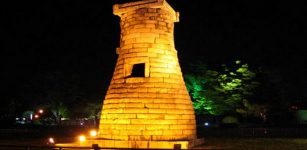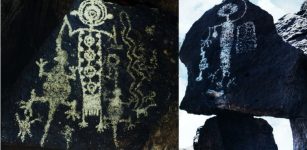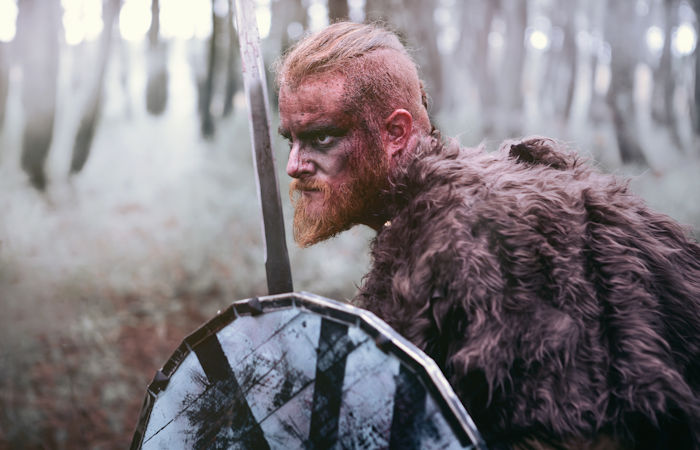Erik The Red: Famous Viking Outlaw Who Colonized Greenland And Was Father Of Leif Erikson
Ellen Lloyd - AncientPages.com - Erik the Red was a famous Viking today remembered for colonizing Greenland and being the father of the great Viking explorer Leif Erikson.
Credit: Adobe Stock - Gelpi
Erik the Red's life was full of difficulties, and was a very controversial Viking. He was very violent, and his temper was beyond control. It resulted in him being exiled from his country on two occasions! Even his fellow citizens got tired of him because he didn't know where to draw the line.
However, this didn't stop Erik the Red from accomplishing many things.
Who was this great Viking who changed Greenland's history?
What Are Norse Sagas Telling About Erik The Red?
Erik Thorvaldsson (approx. 950-1003 AD), better known as Erik the Red, was a Norwegian Viking and son of Thorvald Asvaldsson and Åsvald Åsvaldson.
Born in Rogaland on the southwestern tip of Norway, Erik the Red was forced to leave his home country when his father was exiled from Norway for manslaughter. The family traveled to Iceland, where they settled down and where Erik the Red grew up.
His temper, red hair, and beard earned him the nickname "Erik the Red." After his father's death, Erik the Red married Thjodhild Jörundsdóttir, moved from northern Iceland and settled in Haukadale, which he called Eriksstead.
Brattahlíð – 21st-century reproduction of Thjodhild's church, with Eriksfjord in the background. Image credit: Hamish Laird - Public Domain
Together with his wife, he seemed to enjoy life, but it didn't take long before everything changed.
Erik The Red's Revenge For The Killing Of His Thralls
From the Saga of Erik the Red, we learn that by mistake, some of his thralls (enslaved people) triggered a landslide that crushed his neighbor Valthjof's house one day. A relative of Valthjof, Eyiolf the Foul, killed Erik's thralls. Erik the Red was furious and sought revenge. He killed Eydjiolf and Holmgang-Hrafn, a sometime "enforcer" for the clan. Eyiolf's relatives then demanded Erik be banished from Haukadale, and he moved his family north to the island of Oxney in the Breioafjord of Iceland.
Erik The Red Kills His Neighbor For Not Returning His Possessions
Erik the Red set up a new farm safely out of reach of Eyjolf's relatives, but he soon got into trouble again. This time, it was an argument with Thorgest, a fellow settler. Erik the Red had asked Thorgest to keep his setstokkr (inherited ornamented beams of significant mystical value in Nordic pagan religion), which his father had brought from Norway. When he finished his new house, he returned to get them, but Thorgest refused to return his possessions, and Erik the Red killed Thorgest and his son.
 Greenland - Image credit: Samfundet Sverige - Island
Greenland - Image credit: Samfundet Sverige - Island
These murders got Erik the Red exiled for three years in 980.
Erik The Red's Discovery Of Greenland
Erik the Red had no idea where to go and hide. Finally, he decided to explore the land to the west (Greenland). He knew that Norwegian Viking Gunnbjørn Ulfsson had found a large landmass due west of Iceland in the early ninth century. Erik the Red decided to follow the trace and search for Gunnbjørn's mysterious land.
The journey covered approximately 900 nautical miles of open ocean, but the danger was mitigated by the Viking ships' advanced design and Erik the Red's superior navigation skills.
Brattahlíð – 21st-century reproduction of Thjodhild's church, with Eriksfjord in the background. Image credit: Hamish Laird - Public Domain
He sailed in 982 and found the foreign land he had explored for three years. His goal was to set up a colony. In southwestern Greenland, he built a house in a place that was later called Brattalid and served as Greenland's "capital" for many years.
The first Greenlandic parliament was held here, and it is also where Erik the Red's son, Leif Erikson, departed to discover Newfoundland and Labrador. The Norse lived here for approximately the next 500 years.
In 985, Erik the Red's exile sentence expired, and he returned to Iceland. He was convinced he could set up a colony and started to recruit settlers. To make the new land more attractive, he called it Greenland and said plenty of suitable fishing reservoirs existed.
More than five hundred Icelanders agreed to follow him to Greenland, but it was a hazardous trip, and many died on the way. Only 14 of 25 Viking ships managed to cross the ice-cold and dangerous waters. The survivors established several colonies across Greenland and lived as fishermen, hunters, and farmers.
Erik the Red had achieved his goal and never left Greenland again!
Erik The Red Was A Pagan And Terrified Of Christianity
Erik the Red had four children, and they had inherited his adventurous nature. In the summer of 999, his son Leif Erikson left Greenland and traveled to Norway. The purpose of his journey is still being determined, but he managed to find employment with King Olaf Tryggvason as a member of the royal bodyguard. At the time, King Olaf Tryggvason attempted to force Vikings to become Christians, and there was plenty of resistance.
Erik the Red's son, Leif, converted to Christianity and was baptized with his wife. Before King Olaf Tryggvasos died, he convinced Leif to return to Greenland as an evangelist and spread Christianity.
Leif Erikson sailed back and brought the message of Christianity to Greenland. His wife set up the first church in Greenland. He was a proud pagan and considered the new faith a threat. The faith question divided the family and caused arguments. Erik the Red's wife became a devoted Christian, but Erik the Red was terrified.
Where Did Erik The Red Die?
Erik the Red's son, Leif Erikson, explored the eastern coast of the New World 500 years before Columbus set eyes on the Bahamas in 1492. Leif invited his father on the voyage, but according to legend, Erik fell off his horse on his way to the ship and took this as a bad sign, leaving his son to continue without his company.
See also:
In 1002, a group of immigrants arrived in Greenland, and a deadly epidemic ravaged the colony. Many people died, including Erik the Red. The settlements are said to have survived but never grew to more than 2,500–5,000 people. Norse occupation of Greenland endured for about 500 years until climate change and other factors led to the end of European settlement.
Erik the Red died the winter after his son's departure. Leif Erikson did not know his father's death until he returned to Greenland.
Written by Ellen Lloyd – AncientPages.com
Updated on December 5, 2023
Copyright © AncientPages.com All rights reserved. This material may not be published, broadcast, rewritten or redistributed in whole or part without the express written permission of AncientPages.com
Expand for referencesMore From Ancient Pages
-
 Home Of Jesus’ Apostles Found In The Lost Biblical Town Bethsaida
Archaeology | Aug 10, 2017
Home Of Jesus’ Apostles Found In The Lost Biblical Town Bethsaida
Archaeology | Aug 10, 2017 -
 Beautiful 2,300-Year-Old Gold Ring Found In The City Of David
Archaeology | May 30, 2024
Beautiful 2,300-Year-Old Gold Ring Found In The City Of David
Archaeology | May 30, 2024 -
 The Anglo-Saxon Migration: New Insights From Genetics
Archaeology | Sep 21, 2022
The Anglo-Saxon Migration: New Insights From Genetics
Archaeology | Sep 21, 2022 -
 On This Day In History: King Louis XVI Of France Was Put On Trial For Treason – On Dec 11, 1792
News | Dec 11, 2016
On This Day In History: King Louis XVI Of France Was Put On Trial For Treason – On Dec 11, 1792
News | Dec 11, 2016 -
 Anansi The Spider: Trickster And Spirit Of Knowledge In African Mythology
African Mythology | Jul 20, 2016
Anansi The Spider: Trickster And Spirit Of Knowledge In African Mythology
African Mythology | Jul 20, 2016 -
 Recent Unexpected Findings Of Early Sweet Potato Cultivation In Polynesia
Archaeology | Oct 2, 2024
Recent Unexpected Findings Of Early Sweet Potato Cultivation In Polynesia
Archaeology | Oct 2, 2024 -
 2,000 Years Ago Mysterious Foreigner With Unique Ancestry Traveled To Cambridgeshire – Who Was He?
Archaeology | Dec 27, 2023
2,000 Years Ago Mysterious Foreigner With Unique Ancestry Traveled To Cambridgeshire – Who Was He?
Archaeology | Dec 27, 2023 -
 Why The Aztecs Called Themselves ‘Mexica’
Ancient History Facts | Jan 13, 2018
Why The Aztecs Called Themselves ‘Mexica’
Ancient History Facts | Jan 13, 2018 -
 Did Human Middle Ear Evolve From Fish Gills? – Chinese Fossils Reveal
Archaeology | Jun 17, 2022
Did Human Middle Ear Evolve From Fish Gills? – Chinese Fossils Reveal
Archaeology | Jun 17, 2022 -
 18,000-Year-Old Relics Discovered In Oregon – Oldest Home In North America?
Archaeology | Jul 12, 2023
18,000-Year-Old Relics Discovered In Oregon – Oldest Home In North America?
Archaeology | Jul 12, 2023 -
 Cheomseongdae “Star-Gazing Tower” Is The Oldest Observatory In East Asia
Featured Stories | Mar 31, 2021
Cheomseongdae “Star-Gazing Tower” Is The Oldest Observatory In East Asia
Featured Stories | Mar 31, 2021 -
 Underwater Stone Age Village Habonim North Found Off Israel’s Carmel Coast Thrived During Climate Change
Archaeology | Aug 1, 2024
Underwater Stone Age Village Habonim North Found Off Israel’s Carmel Coast Thrived During Climate Change
Archaeology | Aug 1, 2024 -
 Mysterious Coso Petroglyphs In California – Made By Whom And For What Reason?
Featured Stories | Dec 31, 2020
Mysterious Coso Petroglyphs In California – Made By Whom And For What Reason?
Featured Stories | Dec 31, 2020 -
 Revealing 1,200 Years Of Arctic Canadian Cultures And Settlements In Canada
Archaeology | Jul 11, 2024
Revealing 1,200 Years Of Arctic Canadian Cultures And Settlements In Canada
Archaeology | Jul 11, 2024 -
 3,500-Year-Old Tomb Of Egyptian Goldsmith Discovered
Archaeology | Sep 10, 2017
3,500-Year-Old Tomb Of Egyptian Goldsmith Discovered
Archaeology | Sep 10, 2017 -
 Locations Of 11 Lost Ancient Cities Revealed On 4,000-Year-Old Artifacts
Archaeology | Nov 15, 2017
Locations Of 11 Lost Ancient Cities Revealed On 4,000-Year-Old Artifacts
Archaeology | Nov 15, 2017 -
 New Denisovan Fossil: Extinct Humans Inhabited Tibetan Plateau For 160, 000 Years – Study
Human Beginnings | Jul 4, 2024
New Denisovan Fossil: Extinct Humans Inhabited Tibetan Plateau For 160, 000 Years – Study
Human Beginnings | Jul 4, 2024 -
 Mysterious Medes: Was It An Ancient City Of Ecbatana?
Archaeology | Jul 3, 2020
Mysterious Medes: Was It An Ancient City Of Ecbatana?
Archaeology | Jul 3, 2020 -
 Mystery Of The Demon Wall In Sauherad Church Finally Solved
Archaeology | Dec 15, 2021
Mystery Of The Demon Wall In Sauherad Church Finally Solved
Archaeology | Dec 15, 2021 -
 Underwater Ancient Cypress Forest Offers Clues To The Past
Archaeology | Jun 29, 2021
Underwater Ancient Cypress Forest Offers Clues To The Past
Archaeology | Jun 29, 2021



